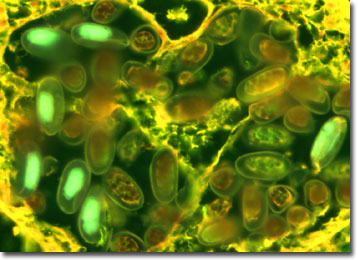Fluorescence Digital Image Gallery
Leech
Leech is a common name for over 650 species of carnivorous, bloodsucking annelid worms that make up the class Hirudinea of the phylum Annelida. They are equipped with a large and a small sucker. The mouth is located on the small sucker and has three jaws with sharp teeth that make a y-shaped incision in the flesh.

When a leech punctures the skin it anesthetizes the wound with its saliva, so that often the victim does not feel a thing. Also the leech's saliva dilates the blood vessels to increase blood flow and prevent the blood from clotting. This anticoagulant is called hirudin and has been used for medicinal purposes for centuries. Bloodletting with the aid of leeches reached its popularity in nineteenth century Europe. It was used to treat many ailments, including pain, skin disorders, and high blood pressure. A common treatment for headaches was to apply several leeches to each temple and allow them to remove the "tainted" blood. This leech craze contributed to the depletion of the European population of leeches.
Today, leeches are used after microsurgery to reduce blood congestion in damaged tissue. Often, blood can flow into the tissue but can't flow out because of swollen, blocked veins. Attaching leeches to the affected area effectively removes the old blood until the outgoing blood vessels have healed. Research is also being conducted on leech saliva for its possible anti-tumor effects.
Leeches are found most often in stagnant freshwater ponds, but can also be found on land and in saltwater habitats. They don't have gills or lungs, but breath through their skin instead. Aquatic leeches can swim, but land leeches move over solid surfaces by muscular expansion and contraction. Aquatic leeches feed on the blood of fish, amphibians, birds, mammals, snails, insect larvae, and worms. True land leeches feed only on the blood of mammals.
Leeches don't carry diseases but can cause death in extreme cases. Small, young specimens of one aquatic leech species, native to Eurasia and Africa, can parasitize both humans and animals. They enter the body either in drinking water or through the excretory openings of persons who bath in infested waters. When ingested through the mouth in drinking water, they attach themselves to the linings of the nose or throat. They can then be inhaled into the lungs, where they can cause anemia and eventually suffocation. Suffocation is a common cause of death for domestic animals in Asia. External wounds from leeches are less dangerous, but they may cause a secondary infection.
The specimen presented here was imaged with a Nikon Eclipse E600 microscope operating with fluorite and/or apochromatic objectives and vertical illuminator equipped with a mercury arc lamp. Specimens were illuminated through Nikon dichromatic filter blocks containing interference filters and a dichroic mirror and imaged with standard epi-fluorescence techniques. Specific filters for the leech specimen were a UV-2E/C, B-2E/C, and a Y-2E/C. Photomicrographs were captured with an Optronics MagnaFire digital camera system coupled to the microscope with a lens-free C-mount adapter.
BACK TO THE FLUORESCENCE DIGITAL IMAGE GALLERY
